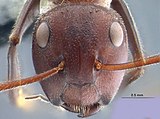Colobopsis explodens
| Colobopsis explodens | |
|---|---|

| |
| Scientific classification | |
| Domain: | Eukaryota |
| Kingdom: | Animalia |
| Phylum: | Arthropoda |
| Class: | Insecta |
| Order: | Hymenoptera |
| Family: | Formicidae |
| Subfamily: | Formicinae |
| Genus: | Colobopsis |
| Species: | C. explodens
|
| Binomial name | |
| Colobopsis explodens Laciny & Zettel 2018[1]
| |
Colobopsis explodens is a species of ant which is found in Southeast Asia. Like some other species in its genus, it is noted for a rare combat mechanism of workers exploding in self-defense, smothering the enemy with toxic and often deadly secretion.[1] This suicidal defensive adaptation also occurs among some species of termites: it is termed autothysis, and as ants and termites are members of practically unrelated insect orders, it comprises a dramatic example of convergent evolution.
Defenses
[edit]

In the past, it was informally known as "yellow goo," named after the brightly colored "goo" produced by its exploding worker ants.
Territory
[edit]They are found in countries in Southeast Asia, such as Thailand, Malaysia, and Borneo. Their colonies can contain thousands of individual ants and inhabit the leafy canopies of trees. The species "Dipterocarpaceae" is noted as a main source of shelter for this particular kind of ants. They fit within the species nesting needs around 131 feet (40 meters) and 197 feet (60 meters) and cover an area of at least 26,900 square feet (2,500 square meters).
Self-defense
[edit]This species is known for its unusual way of self-defense. The earliest recording was in 1916, but it was detailed fully in 1974. When threatened, it will voluntarily flex its gasters and explode, producing a highly toxic chemical sludge (with a spice-like smell) that will hopefully cover and kill or repel said instigator. In addition to helping protect the ant against potentially threatening predators, it is thought due to its "strong antimicrobial and low insecticidal activity of the mandibular gland." to be a way the ants disinfect and protect their nest against harmful bacteria and fungus that could be problems for the colony.
Diet
[edit]They are omnivores, and they are the majority of scavengers. They eat fruits, dead insects, and even fish if it's near their nests.
Gallery
[edit]-
Head of Colobopsis explodens worker
-
Colobopsis explodens worker
-
Colobopsis explodens worker. (a) vertex of major worker (paratype), (b) gastral tergite I, (c) gastral tergite IV of minor worker (holotype), (d) labels of holotype, minor worker
-
Colobopsis explodens soldier. (a) full-face view, (b) frontal shield (c) lateral view, (d) dorsal view
-
Colobopsis explodens queen. (a) full-face view, (b) frontal shield (c) lateral view, (d) dorsal view, (e) forewing with indicated measurements 2r and 4RsM
-
Colobopsis explodens male. (a) full-face view, (b) wings (c) lateral view, (d) dorsal view
-
Colobopsis explodens male reproductive system and genitals. (a) dorsal, (b) ventral (c) lateral view, (d) left penis valve, (e) right volsella and gonostylus
References
[edit]- ^ a b Laciny, A.; Zettel, H.; Kopchinskiy, A.; Pretzer, C.; Pal, A.; Salim, K.A.; Rahimi, M.J; Hoenigsberger, M.; Lim, L.; Jaitrong, W.; Druzhinina, IS (2018). "Colobopsis explodens sp. n., model species for studies on "exploding ants" (Hymenoptera, Formicidae), with biological notes and first illustrations of males of the Colobopsis cylindrica group". ZooKeys (751): 1–40. doi:10.3897/zookeys.751.22661. PMC 5919914. PMID 29706783.
External links
[edit]







